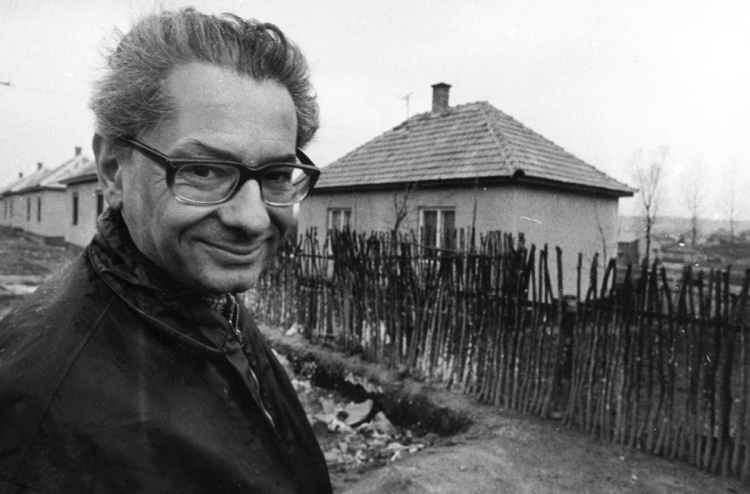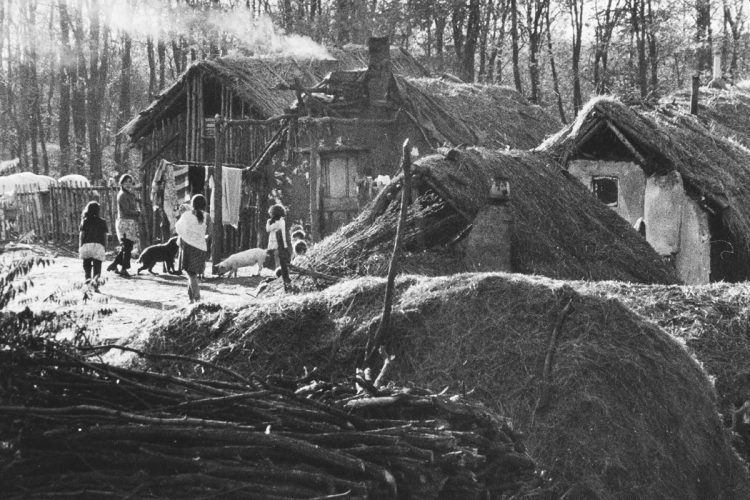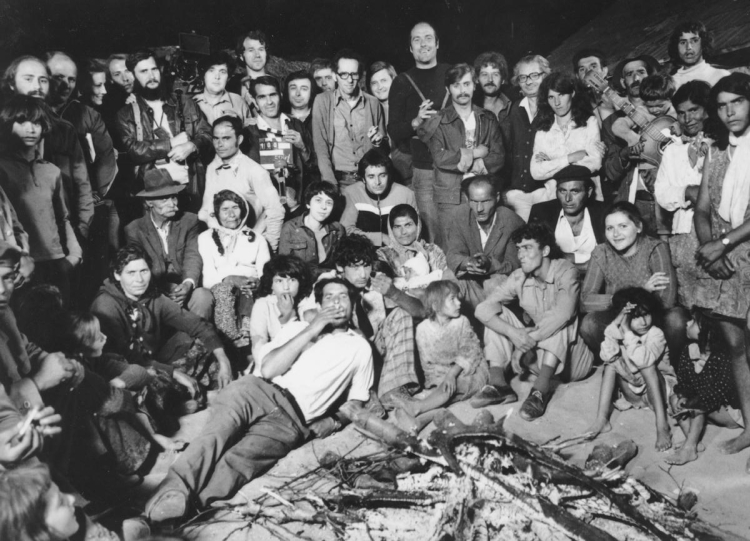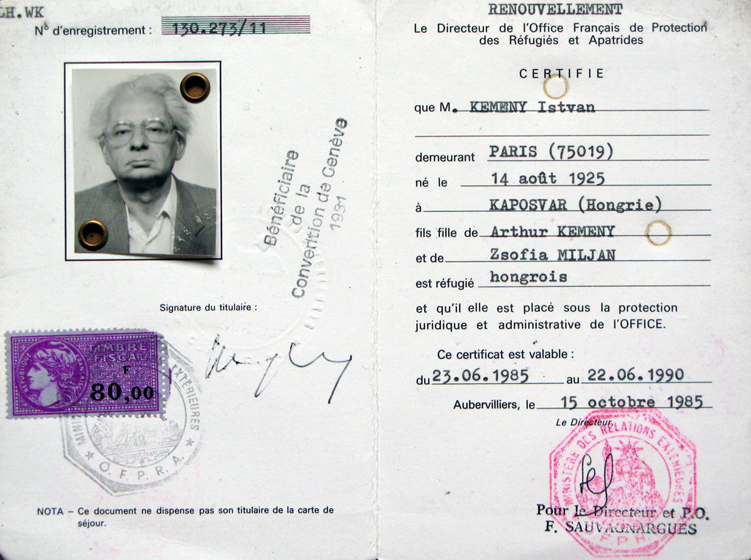Vera and Donald Blinken Open Society Archives
“It Wouldn’t Hurt to Talk More About Gypsies” – A Pioneering Research on the Roma 50 Years Ago Outlined a Dramatic Picture
69 percent lived in settlements on the outskirts of towns or around villages, 88 percent of adults didn't finish primary school.
The next day, I find the husband home, too, who, despite all his wife’s objections, invites me to the room, and offers me a seat. A stocky, balding man with strong confidence; he likes to talk, interposing is hardly necessary or possible. The wife comes in as well, and angrily addresses her husband in Romani, still about not to say anything, because it will be on the radio, which they really don’t need. The man says—now in Hungarian—, so be it, it wouldn’t hurt to talk more about Gypsies anyway, he’s glad to appear on TV, too, to speak his mind.
(HU OSA 369-1-1 Records of the Roma Sajtóközpont Egyesület,
Sociological Survey Interviews Related to the Roma in Hungary 1971)
The above is an excerpt from an interview conducted 50 years ago by one of the contributors of a nation-wide, representative Roma survey led by the sociologist István Kemény. There are nearly 300 similar interviews, results of the 1971 research commissioned by the Office of Councils of the Council of Ministers. On the 50th anniversary, Örs Lehel Tari, Archivist at Blinken OSA, revisits the influential initiative by exploring archival documents, while experts comment on the significance of the research, and the current circumstances of the Roma.
Since a “Roma census” in 1893, the 1971 research was the first scientific survey to uncover in depth the sociological characteristics and the living circumstances of Hungarian Gypsies, says Zsombor Farkas, Assistant Professor at ELTE Faculty of Social Sciences. Beyond giving access to general data on the state of the Hungarian Roma population, according to Angéla Kóczé, Chair of Romani Studies Program at CEU, it provided sharp criticism of the “civilizatory,” often openly racist “Gypsiology” or “Romology” predominant throughout the 1960s and 1970s, which considered the Roma as inferior, primitive. Kemény and his team questioned the Socialist state’s assimilation policy striving, on an ideological level, to improve the circumstances of the most underprivileged workers (and among them, Gypsies).
 István Kemény (1925–2008)
István Kemény (1925–2008)
(Photo: Tamás Féner, Fortepan/Pál Schiffer)
Studying in parallel the Roma population and poverty in general, Kemény had harsh conflicts with the Hungarian academic field’s partisan leadership. In his research on the living conditions of the “low-income” population, he made it clear that low-status workers in the country were fundamentally impacted by poverty, which went against the State Socialist canon. By the time the Roma survey was launched, his conditions had gradually become overly hostile; he could remain employed at the Institute of Sociology of the Hungarian Academy of Sciences only with 1-month contracts that expired at the end of each month. The Roma research was not taken away from him only because of the significant progress he had achieved so far. The project’s political support was not wholly outlandish, Kemény explained it in his later recollections with “the persistence of an attempt among Communist leaders to do something with those in the poorest situation, simply because you cannot think that the Communist regime’s leaders had been, one by one and in all times, ungodly men.”
– If you are that aware that the Roma need help to change, why don’t you and your fellows try and talk to the others?
– But in this, we have the least influence!
– Isn’t it exactly the opposite?
– It’s not, because if I go to them explaining and all, they just say, don’t be a show-off, you are a Gypsy just like us. I cannot tell them in front of the pub to leave and go to work, make money, get a flat and live like a human being, because they would either laugh or punch me in the face. Just have a look at what’s going on in front of the corner pub! They call it the Gypsy Pub. They use axes to clean the windows, and the police just stand there and watch, they don’t pack them off. And we cannot change this. It’s the state that should do more about this, maybe the youth are easier to discipline.(HU OSA 369-1-1 Records of the Roma Sajtóközpont Egyesület,
Sociological Survey Interviews Related to the Roma in Hungary 1971)
According to Vera Szabari, Associate Professor at ELTE Faculty of Social Sciences, Kemény’s research program stemmed from the contemporary attempts at integration, i.e., the survey on the Roma’s circumstances was commissioned to support the implementation of the Gypsy population’s social integration. At that time, this primarily meant assimilation.
One of the major obstacles ahead of data collection was the lack of information on the number and geographical spread of the Roma population in Hungary. The former national census in 1960 estimated 30,000 Gypsies based on their mother tongue, which is strikingly unrealistic. Therefore, the preparation of the research raised the most essential question; who is a Gypsy? Instead of identifying its target group on a voluntary basis, the survey considered those to be Roma who were regarded as Roma by their environment; a handy method at the time, which seems rather unfortunate today.
Planning and carrying out the research required extensive work; the aim was to collect data from 2 percent of the Roma population, reaching out to individuals living in traditional as well as fully urbanized milieus. A challenge in data collection was to win the trust of the Gypsy population (see the first interview excerpt). The research team collected representative samples in every fifth city in Hungary, registered every home inhabited by Romas, and visited one-tenth with a questionnaire. The research team traveled to every city to undertake surveys and conduct in-depth interviews. In-depth interviews, unlike quantitative methods that had become general by the 1970s, are comprehensible even for the common reader. Vera Szabari highlights that the 1971 interview series is also exceptional in including interviews with, beyond the Roma population, town officials and council, school, or police employees, who had regular contact with Gypsy residents. One of the interviewees was a local party secretary, who wished to be fully confidential on her/his Roma origins.
 Film set photo of the 1973 documentary Mit csinálnak a cigánygyerekek? (What do Gypsy children do?) by filmmaker Pál Schiffer.
Film set photo of the 1973 documentary Mit csinálnak a cigánygyerekek? (What do Gypsy children do?) by filmmaker Pál Schiffer.
Kemény was a contributor in several of Schiffer's films.
(Photo: Tamás Féner, Fortepan/Pál Schiffer)
The research results were detailed in a paper published well after the conclusion of the survey. According to the 1971 national survey, 310 thousand Gypsies lived in Hungary, which is 10 times more than earlier estimates. Analyzing the population’s geographical spread, the research found that 69 percent lived either in settlements on the outskirts of towns, or further away, mostly around villages. Criticizing the attempts to close settlements and at resettlement, the paper stated that the forced separation from their village milieus costs the Roma their foundations, as an urban lifestyle is stranger to them, than that of the village. This opinion openly objected to the governmental settlement-clearance program launched not long before, in 1964. Official relocations cut off adhesive traditional norms, the study argued, and, in the end, obstruct the course toward the non-Roma population’s lifestyle; while planned settlements create ghettos. This, however, did not mean that settlements served as ideal habitats; with regard to utilities and hygiene, the conditions were catastrophic, Romanian-speaking settlements (a minority within the Roma population) often lacked electricity and separate wells, while “crowdedness caused neurosis and hostility among residents, impairing peaceful coexistence.” Income per capita in Gypsy families was approximately one-third of that in Hungarian families. The paper explained the gap with the difference in the number of children and the situation of the women, who had more difficulties finding a job due to more children and their rural conditions. While a 1967 survey in all active Hungarian households identified 88 dependents to 100 employed, the same rate in Roma families in 1971 was 235 to 100.
In the neighborhood of the Balatonfűzfő Nitrokémia plant, grapes were eradicated by the chemicals dispersed in the air. Plantations were plowed up, and converted to the more resistant corn. Between the hills, there is a great number of abandoned wine cellars, where homeless Gypsy families find refuge. Between Papvásárhegy, Balatonfűzfő, Litér, and Papkeszi, there is a small settlement with four families. They erected a larger and a modest building next to two wine cellars.
(HU OSA 368-1 István Kemény Personal Papers, Nation-wide Representative Research on the Roma)
In 1971, according to the representative samples, 38 percent of the Roma population older than 14 were illiterate; the worst results came from Romanian-speaking communities, reaching 58 percent. The research found that 88 percent of adult Gypsies did not finish an eight-year primary school. The team had encountered a town where, until 1962, none of the children had gone to school, yet the authorities had not intervened. At that time, councils had no accurate knowledge about the number of children living in the settlements. Quite often the parents denied having school-aged children, and by the time this was uncovered, the children were too old for school. Administrative means were dodged with exemption letters. School teachers approached by the research team agreed that the most common obstacle in school readiness was malnutrition.
Angéla Kóczé concludes that the most important finding of the 1971 survey was that the social conditions of the majority of the Roma population were worse than that of the poorest non-Roma families. This corresponds with the structural violence that—either in the lack of systemic interventions, or despite project-level interventions—sustains the conditions of the Roma, and produces new forms of racism.
/The girl standing by the door cheerfully says something in Romani, pointing at the recorder. Her grandmother interprets/
She asked if I was talking into that. And this child I’ve been raising for what, 10–8 years, is what, 11–14-years old, well but he was three-days old when he was taken from his mother to the hospital. The child was born with throat stricture. Three years he spent in hospital. But you know, his parents became estranged from him, they visited him randomly, I visited him regularly. And when the three years was over, and he could eat, we got the child, well my daughter-in-law was not loving toward him. I said, look, I will adopt him, but you will have nothing to do with him. He was their first. Well for three years he was away, but I say to them, you shouldn’t treat him like that even if he was adopted. I took him with me, I raised him. And once or twice the poor devil didn’t go to school, and I always received these notices, and so the police took him away. So what can I do, I thought I try and send him in for 2–3 months, they will take him in and there he’ll improve. Hell no, he didn’t.
(HU OSA 369-1-1 Records of the Roma Sajtóközpont Egyesület,
Sociological Survey Interviews Related to the Roma in Hungary 1971)
 Cast and crew photo on set from Cséplő Gyuri, a 1978 documentary-feature film by Pál Schiffer. The film's screenplay and dialogs were co-written by Schiffer and Kemény, in parts relying on the 1971 research interviews.
Cast and crew photo on set from Cséplő Gyuri, a 1978 documentary-feature film by Pál Schiffer. The film's screenplay and dialogs were co-written by Schiffer and Kemény, in parts relying on the 1971 research interviews.
Fifth from right, standing in the back wearing glasses, is István Kemény.
(Photo: István Jávor, Fortepan/Pál Schiffer)
In 1976, as his environment became unbearably hostile, and was prohibited from publishing, István Kemény decided to emigrate from Hungary; yet, he contributed to the formation of the socially-sensitive, urban political opposition of the 1980s. Vera Szabari finds it impossible to overrate either the survey’s impact or Kemény’s significance, as far as the later decades’ Hungarian sociology is concerned. Kemény involved many young researchers into his team, such as Zsolt Csalog, János Dávid, Márton Egri, Gábor Havas, Menyhért Lakatos, Mária Neményi, Ottilia Solt, Erika Törzsök. They had meetings every Tuesday in the Institute of Sociology, and later in Kemény’s private apartment. These informal seminars engendered a politically active generation of social scientists; several of Kemény’s colleagues and pupils became members of the Foundation for Supporting the Poor (Szegényeket Támogató Alap, SZETA), an organization openly critical of Hungarian social policy, and the democratic opposition in general. Vera Szabari stresses that such a dual model, incorporating research and education, is sadly lacking today.
A further significant achievement of the 1971 research was that social scientists working on the subject to this day have been relying on its basic methodology. The examined problem requires spatial proximity between researcher and researched phenomenon; therefore, to get involved with the topic, one has to see it with their own eyes. Beyond methodology, such work also requires commitment and benevolent intentions. Zsombor Farkas’s impression is that numerous Roma and non-Roma professionals work—as researchers, on the field, in NGOs, as volunteers—to improve the conditions of the Gypsy in Hungary, to mitigate their exclusion, and to extend the living opportunities of Roma children, especially regarding education.
 Kemény's renewed certificate issued by the French Office for the Protection of Refugees and Stateless Persons in 1985.
Kemény's renewed certificate issued by the French Office for the Protection of Refugees and Stateless Persons in 1985.
(HU OSA 368 István Kemény Personal Papers)
Following the 1989 regime change, István Kemény returned to Hungary, and repeated the survey twice, thus providing insight into the Hungarian Roma population’s experiences since 1971. There were considerable changes in their conditions, says Angéla Kóczé, which, however, is closely connected to parallel social, economic, and political developments during the past 50 years. Vera Szabari points out that while the 1980s saw a significant improvement in the employment of Roma men, that collapsed after the regime change, resulting today in statistics worse than in the 1980s. For instance, even if there was a rise in the level of education among the Roma, the same rise was significantly higher among the non-Roma population, and the eight-years primary school education has devalued on the labor market. As a consequence of Socialist state interventions, highlights Zsombor Farkas, housing conditions did improve—compared to the past at least; still, residential segregation has not dropped. Tens of thousands of Gypsies were inescapably trapped in urban ghettos or village settlements. Somewhat generalizing the issue, summarizes Zsombor Farkas, this is where we are today, more than 30 years after the end of Socialism: close to two-thirds of the Roma population live in poverty or exclusion, and many in extreme poverty, without any prospects. School segregation is rising, around two-thirds of the Roma youth are early school leavers. To this day, hundreds of thousands live in segregation, including a lot of children.
Instead of all this talking, they should help Gypsies, give them—what they need. You see, I don’t need a flat, because we’ve built this on our own, but if a young couple gets together, how can they afford one? They stay at their parents’, and then the children will come, and they will never have the money to buy a home. Especially if they lack the business talent my husband has. Tell me, if a man has a proper job and makes 1,800–2,000 Forints, and perhaps his wife also makes 1200, OK, you can make a decent living out of that, but is it ever going to be enough to get a house?
/The man smiles when she mentions his business talent, and intervenes, but the woman does not let herself be stopped mid-sentence/
(HU OSA 369-1-1 Records of the Roma Sajtóközpont Egyesület,
Sociological Survey Interviews Related to the Roma in Hungary 1971)
The survival of the interview transcripts was not evident, it needed vigilance and luck. István Kemény’s personal papers, preserved at Blinken OSA, comprises around 50 transcripts; lately, the holdings was extended with more than 200 pieces. A member of the 1971 research and pupil of István Kemény, Gábor Havas was informed during the mid-1980s that the Institute of Sociology was about to scrap parts of its archive, and would have thrown out the interviews, had it not been to him. In the 1990s, Havas handed over the transcripts to the Roma Sajtóközpont Egyesület (Roma press center association, RSK) to have them photocopied so that RSK includes them in their archive, making the documents available as source material for scholarly or journalistic work. With the liquidation of the RSK archive, the collection arrived at Blinken OSA, and will be accessible soon.

